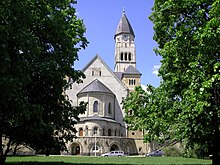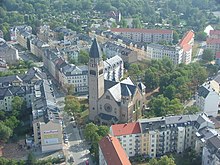Markuskirche (Plauen)
The Markuskirche is located in the northwestern part of Haselbrunn in Plauen .
prehistory
Due to the rapid rise of Plauen, due to the flourishing embroidery industry at the beginning of the 20th century, the Haselbrunn district, which was incorporated in 1899, also developed very quickly. On December 8, 1900, a church building association was founded with an annual membership fee of 2 Marks. From parts of the locust community , the St Paul's and the thimble Witzer rural community of a new church was founded on 1 February 1905, which was given the name "Mark Parish" by the country's Consistory in Dresden on 14 April 1905th At Easter 1905 the first pastor, Dr. phil. Alexander Barthel introduced into his office, at that time still in the gym of the Seumeschule. On February 18, 1906, a competition for the design of a new church started in which 78 designs were submitted. After three drafts were shortlisted, in July 1907 the church council commissioned the architect Heinrich Adam from Berlin to plan the St. Mark's Church. In the meantime, on September 27, 1907, Pastor Kurt Weidenkaff sen. assigned as second pastor. After negotiations about the construction cost, this was reduced from 590,000 marks to 410,000 marks. The result was approved by the church council on February 25, 1910 and by the city council on March 18, 1910. As early as 1907, the Markusgemeinde received the church building site with a size of approx. 2700 m² from the city council against the right of collation and patronage , including all road construction costs and local services. The technical management of the church construction was entrusted to the Plauen City Planning Office and thus the City Planning Officer Wilhelm Goette . The construction engineer Fritz Maul took over the construction, while the architect Heinrich Adam kept the artistic direction.
construction
In June 1910, construction began with the removal of the morning mountain. On April 22, 1911, the foundation stone was laid for the new St. Mark's Church. A year later, the shell was finished except for the main tower. The church was built according to the standards of the time with the "most modern" building materials. The reinforced concrete domed vault made steel roof trusses superfluous, as the vault could also absorb loads from the roof structure. On March 18, 1912, the roof structure of the main roof was completed. On March 7, 1912, the main tower was completely bricked, and on June 20, 1912 it received its roof structure. On July 3, 1912, the copper cross was placed on the globe. The tower had thus reached a total height of 62 meters. The three bronze bells , in the keys es-gs-b, were cast based on the " Gloriosa " rib of Erfurt Cathedral . The largest bell with a weight of 1312 kg bore the inscription "Glory to God in the height", the middle one with 774 kg "Peace on earth" and the smallest with 381 kg "The people are pleased". The consecration of the bells took place on September 10, 1912.
The furnishings were adapted to the neo-Byzantine architectural style and carried out from March to June 1913 under the direction of painter Willi Schomann from Berlin-Charlottenburg. The three large windows in the chancel and the window in the organ gallery were designed by the Munich artist Gustav van Treeck . Even before construction was carried out, the state consistory had rejected the application of the Wiesbaden program as a step backwards. Therefore the organ loft was placed opposite the altar and the pulpit on the side.
organ
The organ building company Eule from Bautzen built the second largest organ in the Vogtland in 1913 . The instrument has 54 stops on three manuals and a pedal.
|
|
|
|
||||||||||||||||||||||||||||||||||||||||||||||||||||||||||||||||||||||||||||||||||||||||||||||||||||||||||||||||||||||||||||
- Coupling : II / I (also as super octave coupling), III / I (also as sub octave coupling), III / II, I / P, II / P, III / P (also as super octave coupling)
The new church was finally consecrated on September 7, 1913.
Conversions and renovations
As early as the First World War , the bronze bells were dismantled on June 22, 1917 by imperial order and melted down for the manufacture of weapons. These were replaced on September 9, 1920 by cast steel bells with the same inscriptions.
The Markuskirche was also damaged on April 10, 1945 by a heavy bombing raid on Plauen in the last days of the Second World War . The roofing and the windows were destroyed. The church was temporarily unusable due to the penetrating rain. The roof was covered again in the summer of 1946 and the damage was gradually repaired over the next ten years.
Right from the start, the St. Mark's parish lacked a suitable meeting room for events outside of the service. The plan of the church council to buy the building opposite the church with the restaurant "Sachsenhof" was prevented by the First World War and inflation. From 1924 a rear building was rented on Seumestrasse, which was used as a community hall. After the war, this temporarily served as the only place for community gatherings. In 1952 the church council decided to build a parish hall on a piece of land on the corner of Herderstrasse and Morgenbergstrasse, which belonged to the community. When the building plans had already been submitted, the property was expropriated by the city council and included in the city's development program. Inspired by Pastor Vödisch, considerations were now made to convert the church building itself, on the one hand to obtain the required parish rooms and, on the other hand, to be able to use (and heat) the church, which has become too large for the smaller parish, more effectively.
In 1963, with the renewal of the tower roof, the roof renovation and with it the major renovation of the church began. After the decision to divide the church at the level of the gallery, a reinforced concrete ceiling was installed in December 1965. For the harvest festival in 1966, the newly created lower hall with approx. 300 seats in the former central nave was consecrated. The altar, the baptismal font and a piece of the pulpit parapet remained in the hall. In 1967 the community rooms in the area under the former side galleries were completed. In the third construction phase, the main roof first had to be rebuilt. The red tile covering was replaced by roofing slate . The neo-Byzantine interior painting was painted over with a simple light color. The newly created chancel in the upper, actual church hall was decorated with wooden artworks by Elly-Viola Nahmmacher from Greiz. The organ was overhauled and new stained glass windows were installed. Finally, on October 5, 1975, the consecration service could be celebrated on the Thanksgiving Festival.
About 28 years after the completion of the major renovation, the upper church hall was to be renovated again. When the necessary expert opinion was to be obtained, the old paint was also removed in some places. It was found that the painting from 1913 was still relatively well preserved. The lower monument protection authority in Plauen then initiated the restoration of the old painting. In 2003 the church hall could be returned to its intended use with the new "old" paint scheme.
literature
- Ev.-Luth. Parish of the Markusgemeinde Plauen (Ed.): Markuskirche Plauen 90 years , Plauen, 2003
Individual evidence
Web links
Coordinates: 50 ° 30 ′ 49.7 " N , 12 ° 7 ′ 43.2" E





